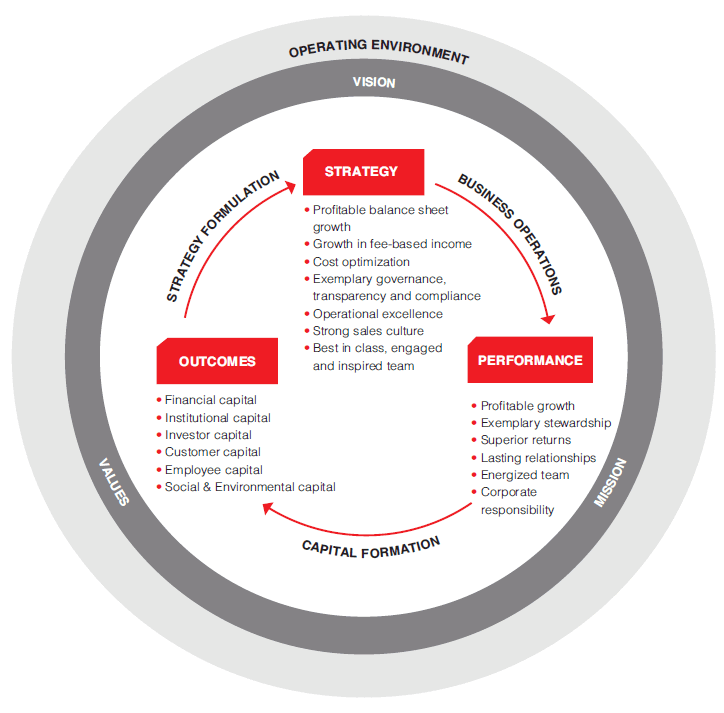Business Model
Value Creation Is the ultimate goal of all what we do
For the Bank to create sustainable value for itself, it must also create value for its stakeholders. Our strategies focus on how we will seize opportunities and mitigate risks in doing so.
Strategy in Action
‘The Strategy-Performance-Outcomes Nexus’

Strategy
The Bank’s business model is underpinned by seven pillars of strategic execution. Our strategies focus on how we will seize opportunities and mitigate risks in our operating environment, and set out plans for resource allocation. The five year strategic plan 2014-2018, prepared in-house, contains the following key elements:
- Profitable balance sheet growth
Aggressive broadening of the asset base through new products; exploring untapped markets coupled with optimum management of net interest margins and share of fee income; efficient allocation of resources.
- Growth in fee-based income
Seeking opportunities for cross-selling within the Group and additional services such as consultancy, legal and custodial services through a linked platform across the Group.
- Cost optimization
Balancing costs and benefits without compromising on the brand value of the Bank.
- Exemplary governance, transparency and compliance
Identifying and managing the various types of risks faced; cultivating an ethical culture throughout the organization while ensuring compliance with all applicable laws, regulations and standards.
- Operational excellence
Focusing on customers’ needs; keeping employees energized and empowered; continuous improvement of systems and procedures to achieve greater efficiency and effectiveness.
- Strong sales culture
Identifying and optimizing customer value creation; capitalizing on cross-selling opportunities.
- Best in class, engaged
and inspired team
Focusing on delivering on business goals through people programmes, plans and initiatives; having an efficient and agile structure with an appropriate mix of skills, technical knowledge and analytical capability coupled with streamlined work processes to enable flawless administration and execution.
Performance
Our business operations transform strategies into results, both financial and non-financial. This involves having in place the required measurement and monitoring systems to assess performance. Accordingly, the Bank's key performance indicators (KPI)
focus on:
- Profitable growth
Driven by balance sheet growth, fee-based income growth and cost optimization
- Exemplary stewardship
Driven by organizational values, corporate governance, risk management and operational excellence
- Superior returns
Driven by total shareholder returns and investor relations
- Lasting relationships
Driven by strong sales culture and market presence
- Energized team
Driven by best in class, engaged and inspired employees who work as a team
- Corporate responsibility
Driven by operational, strategic and philanthropic CSR and environmental stewardship
These in turn support the value creation and capital formation processes that are discussed next.
Value Creation and Capital Formation
In the previous section on stakeholders we identified our key stakeholder groups and how we engage with them. In the section on materiality we distinguished between the Bank and its stakeholders, identified key aspects that affected various stakeholder groups and assessed the importance of these aspects from the perspective of the Bank as well as the stakeholder. Such an analysis (materiality matrix) helps us to refine our business model and create value over time. Value creation lies at the core of all what we do. It is a two-way process. For the Bank to create sustainable value for itself it must also create value for its stakeholders. They go hand in hand.
Outcomes
Value creation leads to capital formation, an outcome, which may be internal or external to the Bank.
The Bank derives value through the dynamic interaction between its external capital and its own internal capital over time. Our internal capital comprises financial capital and institutional capital. The former is what is reported in the financial statements, while the latter are intangibles such as integrity, corporate culture, specialized knowledge and processes, brand image and the like.
The Bank delivers value, both financial and non-financial, to its stakeholders. As stores of value, they comprise investor capital, customer capital, employee capital and social & environmental capital.
Value creation is a dynamic process with flows taking place between the various forms of capital all the time. Although the Bank does not ‘own’ any of its external forms of capital it has access to and uses them, and along with its own internal forms of capital, creates value for itself and for its stakeholders.
The dynamic relationship between strategy, performance and outcomes is shown schematically in the diagram given above. The outcomes are the various forms of capital discussed previously, which are the consequences of the Bank’s strategy, operations and performance. This value creation and capital formation process is not static, and the feedback loop provides the basis for evaluating and refining the Bank’s strategies in going forward. Our reporting, particularly the Management Discussion and Analysis, is thus structured along these lines.
Management Approach
The location of an aspect mapped on the materiality matrix determines its relative importance in affecting the Bank’s ability to create value over time. The various forms of capital which represent stores of value change from time to time, based on the business strategy and activities undertaken. The Bank has access to and makes use of these forms of capital in creating value for itself and its stakeholders through its business model.
The Management Discussion and Analysis that follows explains why we consider an aspect to be material, what we do to manage them and how we evaluate our approach and results. They are elaborated further with supporting performance indicators and measures where applicable.